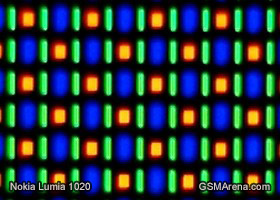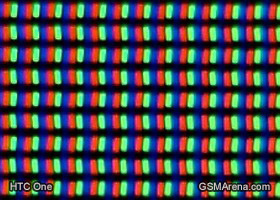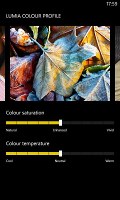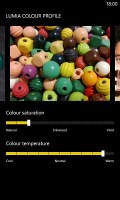Nokia Lumia 1020 360-degree spin
There are two ways to look at the Nokia Lumia 1020 dimensions. At 130.4 x 71.4 x 10.4 mm the smartphone certainly isn't the most compact around - it's somewhat wider and much thicker than the Galaxy S4 (136.6 x 69.8 x 7.9 mm) and that one has a 30% larger battery and 23% bigger screen.
On the other hand, the Lumia 1020 has the same footprint as its predecessor, the Lumia 920 (130.3 x 70.8 x 10.7 mm) and is even slimmer than it if you don't count the bulge for the camera. The comparison with the 13.9mm thick 808 PureView is also favorable for the Lumia 1020. Granted the original PureView handset had a larger sensor, which means much larger camera module, but the Lumia 1020 has a brighter F/2.2 lens and OIS and both of these require quite a lot of room.
The weight of 158g is easily felt when you hold the Nokia Lumia 1020 in your hand or in your pocket, but it's still better than the 185g Lumia 920 or the 169g 808 PureView.
Design and build quality
Looking at the front of the Lumia 1020, the smartphone is almost identical to its Lumia 920 predecessor. The only giveaway is the fact that the bulging camera module makes it sit at an angle when placed on a table or other level surface.
The build and finish quality are certainly among the best in business, although we have to admit the design isn't as striking as it was nearly a year ago, when the Lumia 920 launched. But even if it's a little played out now, the unibody feels impressively sturdy and with the color being inherent to the material and not simply painted on top, it will certainly last a for quite a while and scratches will be harder to spot.
At its launch, the smartphone will be available in three color versions - the yellow one (like our test unit here) is the so-called lead color, meaning that it stars in most promo materials, but there's also a black and a white version.
We guess Nokia will add a few more options to the range further down the road (the Lumia 920 is available in 5 different colors), but even as it is now, the smartphone offers more choice than many of its competitors.
Display
The Nokia Lumia 1020 comes with the same PureMotionHD+ AMOLED display as the Lumia 925. There's Gorilla Glass 3 protection on top, to keep scratches away and provide extra impact resistance. The company chose to move away from LCD panels for its flagships after the Lumia 920 and we suspect the reason for this is keeping the thickness to a reasonable level.
Of course an AMOLED panel has many other advantages such as more vibrant colors and far superior contrast. Nokia has even supplied the Lumia 1020 will a cool color profile app that lets you tune the saturation and color balance to your liking - if oversaturated colors aren't your thing you can go tune them down to more realistic levels and if you like that effect you can go all the way up.
The Nokia Lumia 1020 touchscreen also supports operation with gloves, which might come in handy when operating the flagship in the winter.
As far as image quality is concerned, the Lumia 1020 display performs excellently - it has good brightness levels for an AMOLED screen and excellent viewing angles. Blacks as typical for the technology are as deep as they get.
| Display test | 50% brightness | 100% brightness | ||||
| Black, cd/m2 | White, cd/m2 | Black, cd/m2 | White, cd/m2 | |||
| Nokia Lumia 1020 | 0 | 172 | ∞ | 0 | 398 | ∞ |
| Nokia Lumia 920 | - | - | - | 0.48 | 513 | 1065 |
| HTC One | 0.13 | 205 | 1580 | 0.42 | 647 | 1541 |
| Samsung Galaxy S4 | 0 | 201 | ∞ | 0 | 404 | ∞ |
| Apple iPhone 5 | 0.13 | 200 | 1490 | 0.48 | 640 | 1320 |
Sunlight legibility is pretty decent, although not exactly as great as on the 808 PureView and its much brighter AMOLED screen.
Sunlight contrast ratio
- Nokia 808 PureView4.698
- Motorola RAZR i2.366
- Samsung Galaxy Note II2.307
- Apple iPhone 4S2.269
- HTC One X2.158
- Nokia N82.144
- Nokia Lumia 10202.103
- Oppo Find 52.088
- BlackBerry Z102.051
- Apple iPhone 42.016
- Sony Ericsson Xperia ray1.955
- Samsung Galaxy Camera1.938
- Samsung Galaxy mini 21.114
The only part of the screen that is not class-leading is its resolution. 768 x 1280 pixels still adds to a pixel density of 332 ppi, meaning that you won't be able to discern individual pixels, but flagship Androids have already crossed the 400ppi mark and are even sharper. Granted, the difference isn't huge, but it's there.
The Lumia 1020 employs a PenTile matrix, which means that it has two sub-pixels per pixels, and that reduces the perceived sharpness on some occasions. It's certainly not too irritating and you probably won't even feel the difference until you put the Lumia 1020 next to, say, the HTC One, but it's there.


- Nokia 808 PureView4.698
- Motorola RAZR i2.366
- Samsung Galaxy Note II2.307
- Apple iPhone 4S2.269
- HTC One X2.158
- Nokia N82.144
- Nokia Lumia 10202.103
- Oppo Find 52.088
- BlackBerry Z102.051
- Apple iPhone 42.016
- Sony Ericsson Xperia ray1.955
- Samsung Galaxy Camera1.938
- Samsung Galaxy mini 21.114












No comments:
Post a Comment